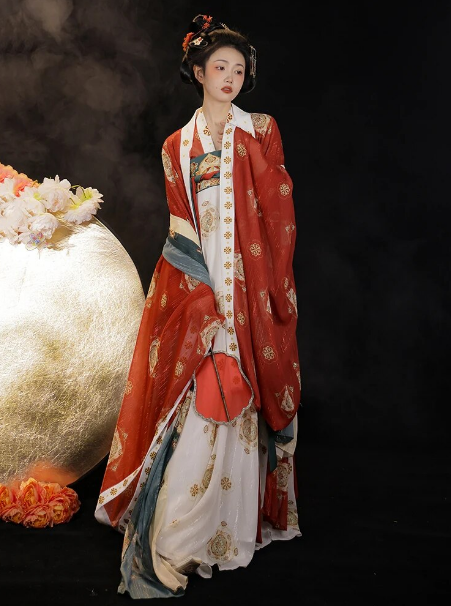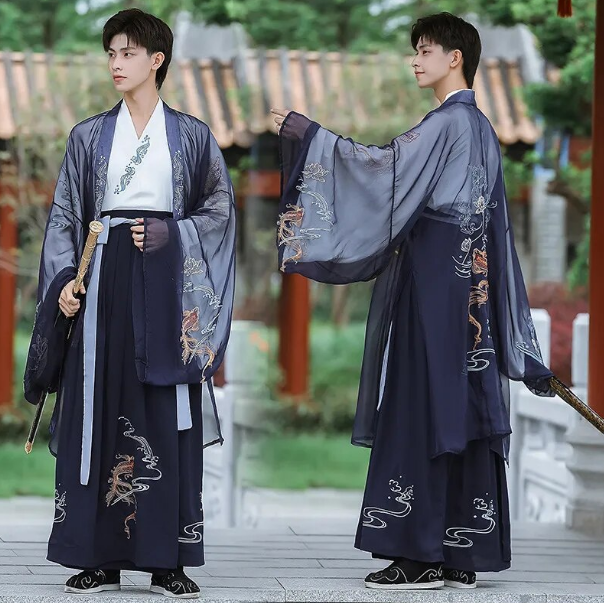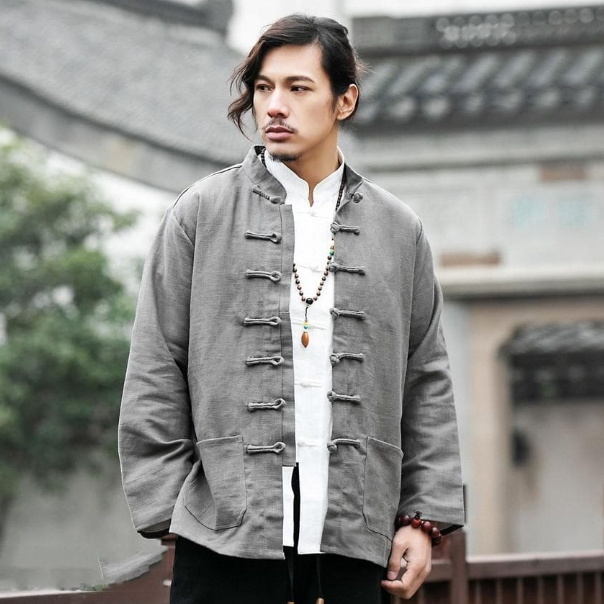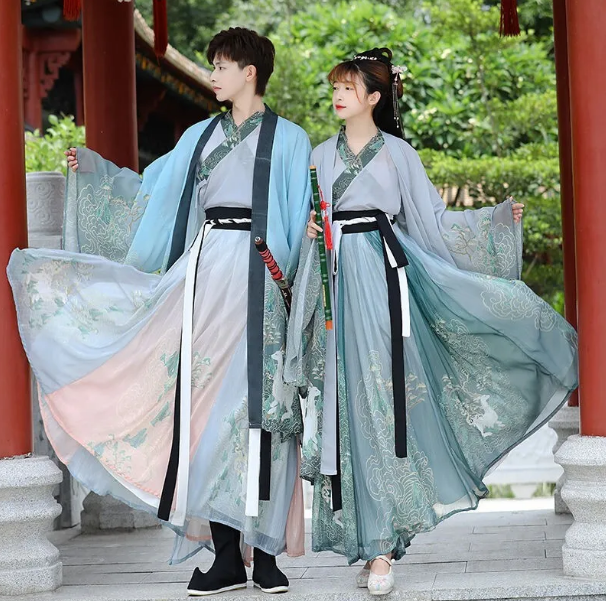Introduction
Exploring traditional Chinese clothing not only reveals a world of historical and cultural richness but also uncovers the evolution of Chinese society through its fabric and design. This exploration primarily focuses on understanding two iconic garments: the Tang Suit and Hanfu. These garments exemplify the aesthetics, philosophy, and cultural norms of their respective eras in Chinese history.
Defining “Tang Suit” and “Hanfu”
Tang Suit
Often misconceived as a product of the Tang Dynasty, the modern Tang Suit actually finds its origins in the late Qing Dynasty. This garment reflects a blend of traditional Chinese clothing style and the influence of Western dress norms that seeped into China during the 19th and 20th centuries. Characterized by its mandarin collar and frog buttons, the Tang Suit today symbolizes a fusion of historical Chinese fashion with modernity.

Hanfu
Literally “Han clothing,” represents the traditional dress of the Han Chinese, the ethnic majority of China. Hanfu traces back over 3,000 years, characterized by its cross-collar, wrapping the right side over the left, and wide sleeves. This attire vividly showcases the elegance and ethereal quality of ancient Chinese fashion. Learn more about Hanfu.
Overview of Traditional Chinese Clothing
Chinese clothing is not just a means of covering the body but also an embodiment of the country’s deep-rooted aesthetics and values. It has evolved through several dynasties, each leaving its distinctive mark on styles, fabrics, and colors.
Diversity through Dynasties
Each Chinese dynasty has contributed uniquely to the evolution of traditional attire. For instance, the Han Dynasty is celebrated for simplifying clothing styles in contrast to the ornate nature of Tang Dynasty outfits, which showcased more flamboyant designs and vibrant colors.
Materials and Techniques
Silk, a prominent material in Chinese clothing, demonstrates China’s ancient expertise in sericulture. Exquisite embroideries and delicate patterns on these silk garments reflect China’s rich tradition in textile artistry and needlework.
Color Symbolism
Colors in traditional Chinese clothing hold significant symbolic meanings. Red, often associated with luck, happiness, and joy, is frequently used in festival costumes and bridal wear. In contrast, white, once used primarily for mourning, has evolved in modern fashion interpretations.
Brief summary
This exploration into Tang Suit and Hanfu provides not just an understanding of the garments themselves but also offers a lens into Chinese culture, art, and history. As we unravel their stories, it becomes evident that these clothing styles are more than just fashion; they are carriers of heritage, identity, and tradition in Chinese society.
Historical Development of Hanfu
Tracing the origins and transformation of Hanfu not only reflects the evolution of Chinese clothing but also illustrates the shifts in Chinese culture, society, and aesthetics over thousands of years. Hanfu, with its deep historical roots and varying styles, offers a glimpse into the rich tapestry of China’s past.
Origins and Evolution
Early Beginnings
The earliest form of Hanfu appeared during the era of Huangdi and Yandi, two legendary figures in Chinese mythology. However, it was during the Shang Dynasty (c. 1600 – 1046 BC) that the basic features of Hanfu began to take shape, characterized by a Yi (a narrow-cuffed, knee-length tunic tied with a sash) and a Chang (a long skirt). More about the Shang Dynasty Hanfu.
Han Dynasty: The Standardization
The Han Dynasty (206 BC – 220 AD) is often considered the golden age for Hanfu, where it got its name and became standardized. This period saw the rise of the Shenyi, a garment that integrated the Yi and the Chang into a single piece, symbolizing unity and modesty.
Influence of Buddhism and Silk Road
The introduction of Buddhism and the opening of the Silk Road during the later dynasties, especially the Tang, brought significant foreign influences to Hanfu. This era saw wider sleeves, the use of luxurious materials like silk, and vibrant colors, reflecting the cosmopolitan nature of the society then.
Variations Across Dynasties
Tang Dynasty: A Flourishing of Styles
The Tang Dynasty (618 – 907 AD) is often hailed for its fashion, where Hanfu saw increased diversity in style and elegance. The Tang women’s attire, known for its high waistlines and broad sleeves, exhibited the dynasty’s openness and preference for opulent aesthetics. Tang Dynasty Fashion.
Song and Ming Dynasties: Resurgence of Conservatism
During the Song (960 – 1279 AD) and Ming (1368 – 1644 AD) dynasties, Hanfu demonstrated a return to conservatism, with a focus on simplicity and elegance. The Zhiju, a straight-lined robe worn during the Ming Dynasty, became an iconic example of this period’s Hanfu.
Qing Dynasty: The Decline and Transformation
With the rise of the Qing Dynasty (1644 – 1912) and the imposition of Manchu clothing styles, traditional Hanfu saw a decline. However, the influence of Hanfu persisted, adapting and evolving in various forms, finding its way into modern Chinese clothing styles and continuing to influence fashion trends.
Brief summary
The historical journey of Hanfu is not just a chronicle of changing fashion but also a mirror reflecting the social, political, and cultural shifts in China. From the rudimentary forms of the Shang Dynasty to the intricate designs of the Tang and the simplicity of the Ming, Hanfu has evolved, symbolizing the enduring spirit and rich heritage of Chinese culture.
The Tang Dynasty and Its Fashion Influence
The Tang Dynasty, often remembered as a pinnacle of Chinese civilization, was also a golden age for fashion. The period stood out for its unique styles, vibrant culture, and inclusive attitude towards foreign influences, which significantly impacted its clothing trends. This era’s fashion influence extended far beyond its time, leaving a lasting imprint on Chinese apparel.
Characteristics of Tang Dynasty Apparel
Rich and Varied Styles
The Tang Dynasty’s clothing was renowned for its rich variety, flamboyant colors, and luxurious materials. Women’s clothing, especially, broke away from previous norms, featuring high waistlines, broad sleeves, and skirts with multiple layers. The use of silk, satin, and other fine fabrics was common, reflecting the dynasty’s wealth and cultural prosperity.
Influence of Multiculturalism
Tang Dynasty’s capital, Chang’an, was a cosmopolitan city where cultures from along the Silk Road converged. This multiculturalism influenced Tang fashion, incorporating elements from Central Asia, Persia, and even Byzantium. Such incorporation led to bolder styles and patterns, a departure from the earlier, more conservative Hanfu designs.
Hairstyles and Accessories
Elaborate hairstyles and accessories were hallmarks of Tang fashion. Women often wore their hair in high buns adorned with intricate hairpins and combs, and they used a variety of accessories like silk ribbons and jade ornaments, further emphasizing the dynasty’s love for grandeur and luxury. Tang Dynasty Fashion.
Comparison with Earlier Hanfu Styles
Simplicity to Splendor
Contrasting with the relative simplicity of Hanfu from the Han and pre-Tang periods, Tang clothing was more elaborate and luxurious. While earlier Hanfu styles focused on a more unified and modest aesthetic (as seen in the Shenyi), Tang attire was about individual expression and flamboyance.
Diversity in Garments
Prior to the Tang, Hanfu generally comprised a set pattern of Yi (a narrow-cuffed, knee-length tunic) and Shang (skirts). The Tang Dynasty, however, introduced variations like the Qixiong Ruqun, a high-waisted skirt, and the Beizi, a long jacket, demonstrating a significant diversification from traditional Hanfu.
Gender Fluidity in Clothing
One of the unique aspects of Tang fashion was its blurring of gender lines in clothing. Unlike in earlier periods, where male and female clothing were distinctly different, Tang Dynasty saw styles that were sometimes androgynous, a trend not prevalent in previous dynasties.

Brief summary
The fashion of the Tang Dynasty, with its bold styles, luxurious fabrics, and inclusive design ethos, marked a significant evolution in the history of Chinese clothing. This era, characterized by its openness to external influences and innovation in styles, not only transformed traditional Hanfu but also set a benchmark in Chinese fashion that resonates to this day.
The Modern Tang Suit: Origins and Influences
The modern Tang Suit, often associated with traditional Chinese attire, is actually a product of relatively recent history. It represents a fusion of Chinese and Western sartorial styles, evolving through significant historical events and cultural exchanges. Unlike its name suggests, the modern Tang Suit doesn’t originate from the Tang Dynasty but has its roots in the late Qing Dynasty and early Republican period.
The Impact of Western Styles
Integration of Western Elements
The late 19th and early 20th centuries were periods of significant cultural and political change in China, marked by increased contact with Western nations. This interaction led to the incorporation of Western tailoring techniques and styles into Chinese clothing. The modern Tang Suit, known for its Mandarin collar and button knots, is a result of this cross-cultural fusion, combining the Western suit’s cut and form with traditional Chinese elements.
Adaptation and Adoption in Modern Times
With the upheaval of the Qing Dynasty and the rise of the Republic of China, fashion became a symbol of national identity and modernity. Chinese reformers and intellectuals, while adopting Western ideologies and systems, sought to retain Chinese cultural elements in their attire. This led to the modern Tang Suit becoming a popular form of dress among Chinese men, symbolizing a blend of tradition and modernity.
Distinction Between Traditional Hanfu and Modern Tang Suit
Difference in Origin and Style
Contrary to the modern Tang Suit, traditional Hanfu has its roots in ancient China, tracing back over 3,000 years. While Hanfu typically features cross-collar, wide sleeves, and sash belts, the modern Tang Suit is characterized by a straight collar, buttoned front, and a more structured silhouette. This distinction underlines the evolution of Chinese fashion from the flowing, draped garments of ancient times to the sharper, tailored lines influenced by Western styles.
Cultural and Symbolic Significance
While Hanfu is seen as a symbol of China’s ancient civilization and cultural heritage, the modern Tang Suit represents the adaptability and resilience of Chinese culture in the face of global influences. The Tang Suit, often worn during formal occasions and national festivities, has become a symbol of Chinese identity in the modern era, differentiating itself from the historical Hanfu, which is more associated with traditionalism and ancient rituals.
Brief summary
The evolution of the modern Tang Suit from traditional Chinese clothing and its subsequent influence by Western fashion reflects the dynamic nature of cultural interactions and identity. Standing distinctly apart from the ancient Hanfu, the Tang Suit symbolizes not just a unique style but a narrative of China’s journey through history, modernization, and globalization.

Cultural Significance and Contemporary Perspectives
In the tapestry of Chinese clothing history, both Hanfu and the Tang Suit hold distinct places, resonating with cultural significance and contemporary relevance. While Hanfu echoes the depth of ancient Chinese civilization, the Tang Suit reflects the dynamic interplay of tradition and modernity. In contemporary times, these garments are not just fashion statements but also mediums of cultural expression and identity.
Hanfu Movement and Cultural Identity
Revival of Traditional Heritage
The Hanfu movement, a grassroots cultural trend that began in the early 21st century, advocates for the revival of ancient Han Chinese clothing. This movement, gaining momentum through internet forums and social media, symbolizes a resurgence of interest in traditional Chinese culture. Young Chinese, in particular, are embracing Hanfu as a way to connect with their heritage, often wearing these outfits during festivals, traditional ceremonies, and public gatherings.
Expression of National Pride
The Hanfu movement also intertwines with larger themes of national pride and cultural confidence. In an era marked by globalization, Hanfu enthusiasts view the adoption of ancient attire as a means to assert Chinese cultural identity on the world stage. It’s a statement about valuing the past and shaping a unique Chinese narrative in the global cultural milieu. More about Hanfu Movement.
The Role of Tang Suit in Modern Chinese Fashion
Symbol of Modern Chinese Elegance
While Hanfu has its roots in a distant past, the Tang Suit plays a more contemporary role in Chinese fashion. Often seen during important events like Chinese New Year, political gatherings, and international meetings, the Tang Suit has become a symbol of modern Chinese elegance and diplomacy. It’s a garment that communicates respect for tradition, alongside an embrace of the modern world.
Adaptability and Fusion
The adaptability of the Tang Suit, blending traditional Chinese motifs with Western-style tailoring, makes it uniquely versatile in modern fashion. Designers often experiment with fabrics, colors, and cuts, adding innovative twists to the classic Tang Suit, thereby keeping it relevant in contemporary fashion scenarios. This fusion wear exemplifies how traditional Chinese aesthetics can find new expressions in the age of globalization.
Brief summary
The journey of Hanfu and the Tang Suit through Chinese history is a narrative of cultural pride, identity, and the evolution of traditions. As symbols, these garments speak volumes about the Chinese spirit: respecting and reviving the old while boldly marching towards the new. In the current era, where fashion and identity intersect, Hanfu and the Tang Suit stand as testaments to the richness and dynamism of Chinese culture.

Conclusion
The exploration of Tang suits and Hanfu reveals much more than the historical and stylistic aspects of traditional Chinese clothing. It delves into the profound realms of cultural identity, heritage, and the dynamic nature of fashion as a form of cultural expression. Understanding these garments in their historical and modern contexts offers insights into the broader narrative of Chinese cultural and fashion evolution.
Understanding the Differences and Commonalities
Embracing Diversity within Tradition
Although Tang suits and Hanfu originate from different historical periods and stylistic influences, both play crucial roles in the tapestry of Chinese culture. The Tang suit, with its modern silhouette and cross-cultural influences, represents the fusion of Eastern and Western aesthetics, reflecting China’s modern history of interaction with the outside world. Hanfu, with its ancient roots and symbolic value, embodies the continuity of Chinese traditional culture.
Shared Cultural Significance
Despite their differences, both these styles share a common ground in their cultural significance. They are not merely clothes but symbols of Chinese heritage and pride. Both have seen revivals in different ways – Hanfu, through the grassroots movement among the youth, and Tang suits as formal wear symbolizing modern Chinese elegance. These revivals speak volumes about the ongoing conversation in China regarding national identity and cultural preservation.
The Future of Traditional Chinese Attire in Global Fashion
Incorporation into Global Fashion Trends
As global fashion increasingly embraces diversity and cultural narratives, traditional Chinese attire like Hanfu and Tang suits have the potential to gain more international attention. Designers from around the world are showing interest in incorporating elements of these traditional styles into contemporary fashion, creating a blend that respects tradition while innovating for modern sensibilities.
Symbol of Global Cultural Exchange
Traditional Chinese clothing, when adapted and integrated into global fashion, can act as a bridge between cultures, promoting mutual understanding and appreciation. As fashion continues to be a powerful medium for cultural exchange, Hanfu and Tang suits stand to play significant roles, not only as emblems of Chinese culture but also as contributions to the global fashion dialogue.
Final Thoughts
The journey from traditional Hanfu to the modern Tang suit encapsulates a story of transformation, resilience, and renaissance. These garments, emblematic of China’s rich heritage and its dynamic present, continue to evolve, resonating with both the past and the future. As they weave through the fabric of global fashion, they carry with them the spirit of a civilization that is continuously redefining itself, proudly displaying its legacy while boldly embracing new influences.







